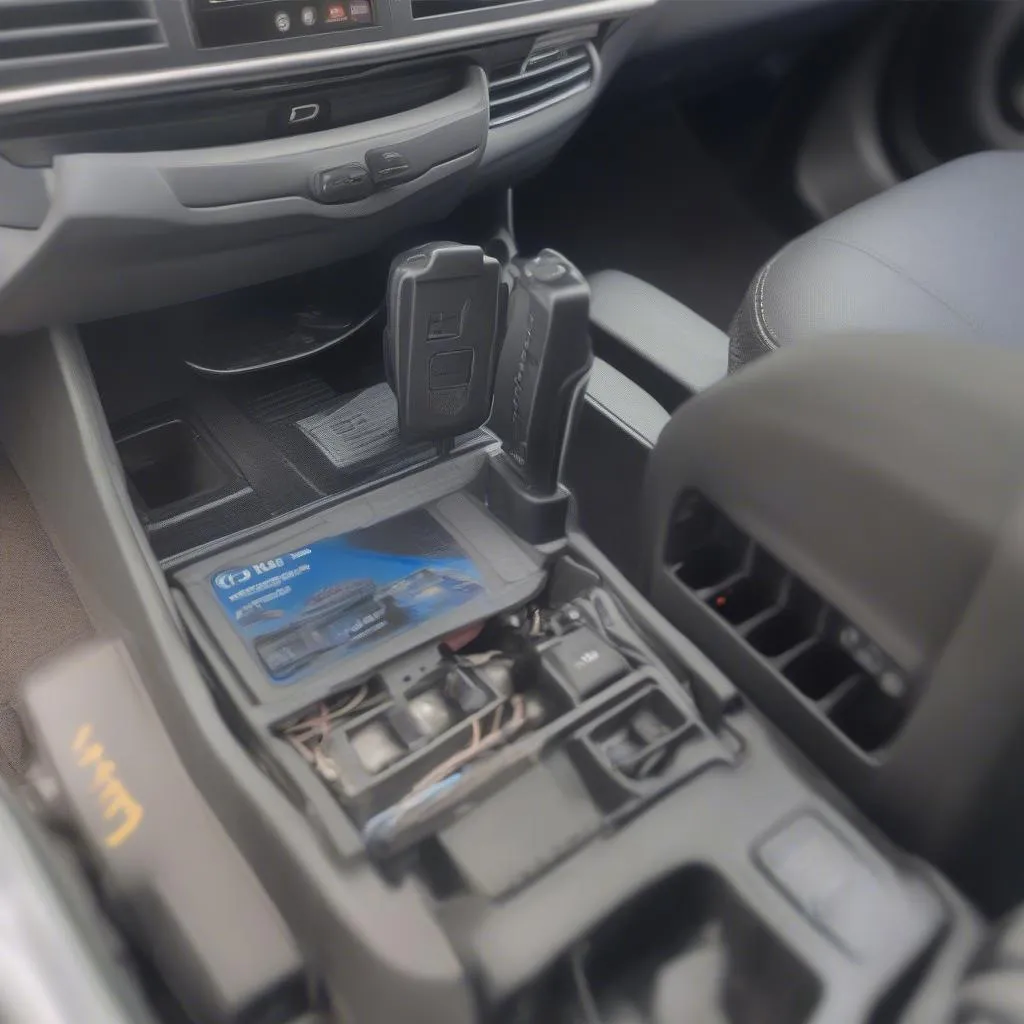OBD2 scanners have become essential tools for car owners and mechanics alike. They provide a window into your vehicle’s computer system, allowing you to diagnose problems, monitor performance, and even clear pesky check engine lights. But before you can unlock these features, you need to know where to connect your OBD2 scanner.
Locating the OBD2 Port in Your Vehicle
Finding the OBD2 port might seem daunting, especially if you’re new to car maintenance. Luckily, it’s usually in one of a few standard locations.
-
Under the dashboard: This is the most common location. Look for a trapezoidal-shaped connector with 16 pins, usually near the steering column or the ashtray area.
-
Beneath the steering column: In some vehicles, the port might be located under a panel below the steering wheel.
-
Inside the center console: If you can’t find it under the dashboard, check inside your center console. It might be hidden beneath a removable panel or inside the armrest compartment.
-
Near the fuse box: Some manufacturers place the OBD2 port near the fuse box, either on the driver’s side or the passenger’s side of the vehicle.
Important Note: The exact location of the OBD2 port can vary depending on the make, model, and year of your vehicle. If you’re having trouble finding it, consult your owner’s manual or perform a quick online search for your specific car model.
Connecting Your OBD2 Scanner: A Step-by-Step Guide
Once you’ve located the OBD2 port, connecting your scanner is a breeze. Follow these simple steps:
-
Ensure your vehicle is turned off: This is crucial to avoid any potential electrical issues.
-
Align and insert the scanner: The connector on your OBD2 scanner should fit snugly into the port. Don’t force it; if it doesn’t fit easily, double-check the alignment.
-
Turn on the ignition: Turn the key to the “on” or “accessory” position, but don’t start the engine. This will power up the scanner and allow it to communicate with your car’s computer.
-
Pair your scanner (if necessary): If you’re using a Bluetooth or Wi-Fi enabled scanner, follow the manufacturer’s instructions to pair it with your smartphone or tablet.
Pro Tip: If you’re encountering connection issues, try cleaning the OBD2 port with electronic contact cleaner and a soft brush. Dust and debris can sometimes interfere with the connection.
Understanding the Different Types of OBD2 Scanners
Not all OBD2 scanners are created equal. There are various types available, each with its own set of features and capabilities:
-
Basic Code Readers: These affordable scanners are ideal for DIY enthusiasts who want to read and clear basic engine codes.
-
Bluetooth Scanners: These scanners connect wirelessly to your smartphone or tablet, allowing you to access more advanced features and diagnostic information through dedicated apps. You can learn more about connecting these specific scanners in our article: how to connect bluetooth obd2 scanner.
-
Professional-Grade Scanners: These high-end scanners are typically used by mechanics and offer comprehensive diagnostic capabilities, including live data streaming, advanced coding functions, and bi-directional control.
Why Connect an OBD2 Scanner?
Connecting an OBD2 scanner to your vehicle opens up a world of possibilities for car owners and enthusiasts:
-
Diagnose Engine Problems: Retrieve and decipher trouble codes to pinpoint the root cause of check engine lights, saving you time and money on unnecessary repairs.
-
Monitor Vehicle Performance: Track real-time data such as engine RPM, coolant temperature, and oxygen sensor readings to gain insights into your vehicle’s health and performance.
-
Clear Check Engine Lights: After addressing the underlying issue, you can use an OBD2 scanner to clear the check engine light and reset the system.
-
Enhance Your Driving Experience: Some advanced scanners allow you to customize vehicle settings, monitor fuel economy, and even record performance data.
Expert Insight: “An OBD2 scanner is an invaluable tool for any car owner. It empowers you to take control of your vehicle’s maintenance and stay ahead of potential problems,” says John Smith, a seasoned automotive engineer with over 20 years of experience.
Common Issues and Troubleshooting Tips
While connecting an OBD2 scanner is usually straightforward, you might encounter a few hiccups along the way:
-
Scanner Not Powering Up: Ensure the ignition is turned to the “on” position and check the fuse for the OBD2 port.
-
Communication Errors: Try cleaning the OBD2 port connectors and ensure the scanner is compatible with your vehicle’s make and model.
-
Inaccurate Readings: Faulty sensors or wiring issues can lead to inaccurate data. Consult a mechanic to diagnose and address these problems.
Conclusion
Knowing where to connect your OBD2 scanner and understanding its capabilities can significantly enhance your car ownership experience. From diagnosing engine problems to monitoring performance, these handy devices provide valuable insights into your vehicle’s health. So, equip yourself with an OBD2 scanner and unlock a new level of automotive knowledge and control.
If you are wondering if an OBD2 scanner can program keys, check out our comprehensive guide: can a obd2 scanner program keys. Also, if you are an Autel user, we have a dedicated guide on how to use autel obd2 scanner.
Need to read OBD2 codes on your Chevy Silverado without a scanner? Find out how in our detailed guide: how to read obd2 codes without scanner chevy silverado. For those interested in cloud connectivity, our guide on how to connect an obd2 scanner to the cloud provides valuable insights.
Contact us via WhatsApp: +1(641)206-8880 or Email: [email protected]. Our customer support team is available 24/7 to assist you.

